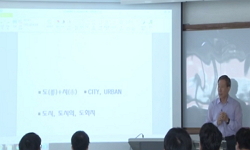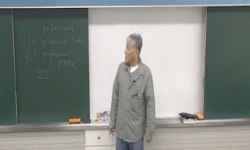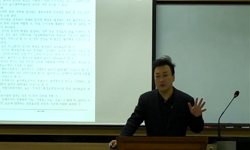지속가능한 발전은 도시의 효율적인 개발과 경제, 사회, 환경적 측면의 보전을 목표로 하기 때문에 중요하다. 그러나 우리나라의 빠른 도시화로 경제적 발전은 이루었지만 자원의 비효율적...
http://chineseinput.net/에서 pinyin(병음)방식으로 중국어를 변환할 수 있습니다.
변환된 중국어를 복사하여 사용하시면 됩니다.
- 中文 을 입력하시려면 zhongwen을 입력하시고 space를누르시면됩니다.
- 北京 을 입력하시려면 beijing을 입력하시고 space를 누르시면 됩니다.

유전 알고리즘을 적용한 토지이용 최적화 배분 연구 - 양평군 양평읍 일대를 대상으로 - = Land Use Optimization using Genetic Algorithms - Focused on Yangpyeong-eup -
한글로보기https://www.riss.kr/link?id=A102929373
- 저자
- 발행기관
- 학술지명
- 권호사항
-
발행연도
2017
-
작성언어
Korean
- 주제어
-
등재정보
KCI등재
-
자료형태
학술저널
-
수록면
44-56(13쪽)
-
KCI 피인용횟수
2
- DOI식별코드
- 제공처
-
0
상세조회 -
0
다운로드
부가정보
국문 초록 (Abstract)
지속가능한 발전은 도시의 효율적인 개발과 경제, 사회, 환경적 측면의 보전을 목표로 하기 때문에 중요하다. 그러나 우리나라의 빠른 도시화로 경제적 발전은 이루었지만 자원의 비효율적인 배분현상을 경험하게 되었고 이는 토지이용 배분도 예외가 아니다. 토지이용 배분의 문제가 어려운 이유는 다양한 목적을 고려해야하기 때문이며 이는 다목적 최적화의 방법에서 그 해결책을 찾을 수가 있다. 본 연구에서는 생태적으로 보존이 잘 되어있으며 인구 증가가 일어나고 있는 경기도 양평지역의 양평읍과 그 일대를 대상지로 선정하였다. 그리고 넓은 공간 탐색에 유리하고 토지이용 배분의 문제에서 널리 사용되고 있는 유전 알고리즘을 사용하였다. 유전알고리즘(GA)는 더 좋은 자손을 얻기 위하여 염색체의 교차 및 돌연변이의 과정을 거치는 적자생존의 원리가 작용하는 진화의 단계가 그 출발점이다. 본 연구는 변이의 방식에 변화를 주었으며 공간적 목적, 토지이용 전환 최소화, 생태계 보전 최대화, 경제적 이익 최대화라는 네 가지 목적과 특정 토지이용의 면적제한과 고정지역 설정이라는 제약요건을 두고 최적 안을 도출해내었다. 생태적으로 보존시켜야 할 곳에는 시가지가 형성되지 않았고, 시가지 면적 증가율이 높은 결과는 최적화의 방향인 `경제적 이익의 최대화`라는 점과 상응하였다. 적합도 값이 최소인 지점이 수렴지점임을 고려했을 때, 1500세대 부근에서 최적화가 일어났음을 알 수 있었다. 본 연구의 결과는 양평읍과 그 일대에 적용시킬 수 있는 효과적인 지원방안을 마련하는데 도움이 될 수 있을 것으로 판단된다.
다국어 초록 (Multilingual Abstract)
Sustainable development is important because the ultimate objective is efficient development combining the economic, social, and environmental aspects of urban conservation. Despite Korea`s rapid urbanization and economic development, the distribution...
Sustainable development is important because the ultimate objective is efficient development combining the economic, social, and environmental aspects of urban conservation. Despite Korea`s rapid urbanization and economic development, the distribution of resources is inefficient, and land-use is not an exception. Land use distribution is difficult, as it requires considering a variety of purposes, whose solutions lie in a multipurpose optimization process. In this study, Yangpyeong-eup, Yangpyeong, Gyeonggi-do, is selected, as the site has ecological balance, is well-preserved, and has the potential to support population increases. Further, we have used the genetic algorithm method, as it helps to evolve solutions for complex spatial problems such as planning and distribution of land use. This study applies change to the way of mutation. With four goals and restrictions of area, spatial objectives, minimizing land use conversion, ecological conservation, maximizing economic profit, restricting area to a specific land use, and setting a fixed area, we developed an optimal planning map. No urban areas at the site needed preservation and the high urban area growth rate coincided with the optimization of purpose and maximization of economic profit. When the minimum point of the fitness score is the convergence point, we found optimization occurred approximately at 1500 generations. The results of this study can support planning at Yangpyeong-eup.ausative relationship between the perception of improving odor regulation and odor acceptance.
참고문헌 (Reference)
1 정삼석, "주거지역 현황과 주거예측모형 면적의 비교·분석을 통한 토지이용 입안계획에 관한 연구 -주거지역사례를 중심으로-" 한국부동산학회 (57) : 195-209, 2014
2 김은영, "국토환경 모니터링 지표로서의 국토환경성평가지도 활용방안" 한국환경정책·평가연구원 11 (11): 3-16, 2012
3 Aerts JCJH, "Using simulated annealing for resource allocation" 16 (16): 571-587, 2002
4 Aerts JCJH, "Using linear integer programming for multi-site land use allocation" 35 : 148-169, 2003
5 Guldmann JM, "Urban land use allocation and environmental pollution control: an intertemporal optimization approach" 13 (13): 71-86, 1979
6 Choi YG, "The research of finding Cooperation of Land Use and Environment policy for 『Developing land harmonized with the environment』" KRIHS 2013
7 Masnavi MR, "The new millennium and the new urban paradigm: the compact city in practice"
8 Park CS, "The Research of Considering Ecological Efficiency of Urban Land Use"
9 Huang B, "Sustainable land-use planning for a downtown lake area in central China: multiobjective optimization approach aided by urban growth modeling" 140 (140): 04014002-, 2014
10 Cao K, "Sustainable land use optimization using Boundary-based Fast Genetic Algorithm" 36 (36): 257-269, 2012
1 정삼석, "주거지역 현황과 주거예측모형 면적의 비교·분석을 통한 토지이용 입안계획에 관한 연구 -주거지역사례를 중심으로-" 한국부동산학회 (57) : 195-209, 2014
2 김은영, "국토환경 모니터링 지표로서의 국토환경성평가지도 활용방안" 한국환경정책·평가연구원 11 (11): 3-16, 2012
3 Aerts JCJH, "Using simulated annealing for resource allocation" 16 (16): 571-587, 2002
4 Aerts JCJH, "Using linear integer programming for multi-site land use allocation" 35 : 148-169, 2003
5 Guldmann JM, "Urban land use allocation and environmental pollution control: an intertemporal optimization approach" 13 (13): 71-86, 1979
6 Choi YG, "The research of finding Cooperation of Land Use and Environment policy for 『Developing land harmonized with the environment』" KRIHS 2013
7 Masnavi MR, "The new millennium and the new urban paradigm: the compact city in practice"
8 Park CS, "The Research of Considering Ecological Efficiency of Urban Land Use"
9 Huang B, "Sustainable land-use planning for a downtown lake area in central China: multiobjective optimization approach aided by urban growth modeling" 140 (140): 04014002-, 2014
10 Cao K, "Sustainable land use optimization using Boundary-based Fast Genetic Algorithm" 36 (36): 257-269, 2012
11 Ligmann-Zielinska A, "Spatial optimization as a generative technique for sustainable multiobjective land-use allocation" 22 (22): 601-622, 2008
12 Cao K, "Spatial multi-objective land use optimization: extensions to the nondominated sorting genetic algorithm-II" 25 (25): 1949-1969, 2011
13 Liu Y, "Regional land-use allocation with a spatially explicit genetic algorithm" 11 (11): 209-219, 2015
14 WCED, "Our common future" Oxford University Press 1987
15 Balling RJ, "Multiobjective urban planning using genetic algorithm" 125 (125): 86-99, 1999
16 Janssen R, "Multiobjective decision support for land-use planning" 35 (35): 740-756, 2008
17 Memmah MM, "Metaheuristics for agricultural land use optimization. A review" 35 (35): 975-998, 2015
18 Wardoyo W, "Measuring and assessing management of forested landscapes" 72 (72): 639-645, 1996
19 Wang X, "Land allocation based on integrated GIS optimization modeling at a watershed level" 66 : 61-74, 2004
20 Zhang W, "Land Use Optimization for a Rapidly Urbanizing City with Regard to Local Climate Change:Shenzhen as a Case Study" 141 (141): 2014
21 Ma X, "Land Use Allocation Based on a Multi-Objective Artificial Immune Optimization Model: An Application in Anlu County, China" 7 (7): 15632-15651, 2015
22 Yang-pyeonggun, "Hope&Happiness Yangpyung"
23 Moon BR, "Easy Classing Genetic Algorithm" Hanbit Media 2008
24 Liu X, "Combining system dynamics and hybrid particle swarm optimization for land use allocation" 257 : 11-24, 2013
25 Morio M, "Applying a multi-criteria genetic algorithm framework for brownfield reuse optimization:Improving redevelopment options based on stakeholder preferences" 130 : 331-346, 2013
26 Stewart TJ, "A multiobjective GIS-based land use planning algorithm" 46 : 25-34, 2014
27 Liu Y, "A land-use spatial optimization model based on genetic optimization and game theory" 49 : 1-14, 2015
28 Stewart TJ, "A genetic algorithm approach to multiobjective land use planning" 31 (31): 2293-2313, 2004
동일학술지(권/호) 다른 논문
-
제주도에 도입된 뉴트리아(Myocastor coypus)의 생물학적 특성 및 서식 현황
- 한국환경영향평가학회
- 김가람 ( Ga-ram Kim )
- 2017
- KCI등재
-
ISO 9613-2를 이용한 철도 환경소음 예측 모델 개선에 관한 연구
- 한국환경영향평가학회
- 장승호 ( Seungho Jang )
- 2017
- KCI등재
-
무주-금산간 도로건설에 따른 적벽강의 어류 종 조성 분석 및 생태건강도 사전환경성평가
- 한국환경영향평가학회
- 이상재 ( Sang-jae Lee )
- 2017
- KCI등재
-
주민참여형 유역관리를 위한 하천모니터링 활동의 적용가능성 연구 - 무심천유역을 대상으로 -
- 한국환경영향평가학회
- 이은정 ( Eunjeong Lee )
- 2017
- KCI등재
분석정보
인용정보 인용지수 설명보기
학술지 이력
| 연월일 | 이력구분 | 이력상세 | 등재구분 |
|---|---|---|---|
| 2027 | 평가예정 | 재인증평가 신청대상 (재인증) | |
| 2021-01-01 | 평가 | 등재학술지 유지 (재인증) |  |
| 2018-01-01 | 평가 | 등재학술지 유지 (등재유지) |  |
| 2015-01-01 | 평가 | 등재학술지 유지 (등재유지) |  |
| 2011-01-01 | 평가 | 등재 1차 FAIL (등재유지) |  |
| 2009-01-01 | 평가 | 등재학술지 유지 (등재유지) |  |
| 2007-01-01 | 평가 | 등재학술지 유지 (등재유지) |  |
| 2004-01-01 | 평가 | 등재학술지 선정 (등재후보2차) |  |
| 2003-01-01 | 평가 | 등재후보 1차 PASS (등재후보1차) |  |
| 2001-07-01 | 평가 | 등재후보학술지 선정 (신규평가) |  |
학술지 인용정보
| 기준연도 | WOS-KCI 통합IF(2년) | KCIF(2년) | KCIF(3년) |
|---|---|---|---|
| 2016 | 0.59 | 0.59 | 0.47 |
| KCIF(4년) | KCIF(5년) | 중심성지수(3년) | 즉시성지수 |
| 0.47 | 0.43 | 0.599 | 0.2 |





 ScienceON
ScienceON KISS
KISS






